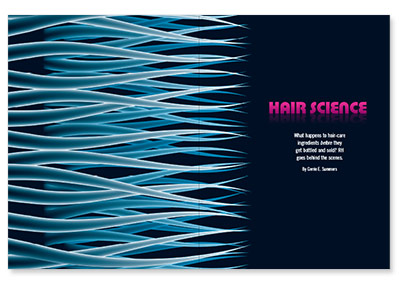
What does a typical hair product go through before it’s put on store shelves? For the answer, Real Health spoke with Ron Robinson, an independent cosmetic chemist who is the founder and CEO of BeautyStat.com. As a former chemist for such prestigious companies as Clinique, Revlon, Lancôme and Estée Lauder, Robinson has developed hundreds of products.
Hair research begins with an idea that addresses a consumer need and a company’s desire to expand a particular product category, explains Robinson, “What happens is either marketing or research and development (R&D) recognizes that there’s a consumer need for a new product.” Enter the company chemists.
“There are different types of roles a chemist plays within a company,” Robinson continues. “There are chemists who do purely research. They study the science behind different ingredients and raw materials. Then, there are those who actually work to formulate a product. They are the ones responsible for combining ingredients in the right ratio that creates the final product a company launches in the marketplace. Finally, there are chemists who do both. I did a little bit of both, but mostly I worked on the formulating part. I was responsible for putting the actual ingredients together in the right ratio and the right concentration to create a finished product.”
To do this, a chemist researches plants and other ingredients that when combined produces results that address specific hair issues. “The job of the chemist is to understand all the different ingredients out there and how to combine them, what percentage needs to be combined or could be mixed to create a product that is going to deliver some sort of performance or action.”
Hair product scientists work in a typical laboratory setting: Picture them in white lab coats and goggles standing in front of counters with numerous jars of ingredients, along with test tubes and microscopes to study hair strands and the effects of these ingredients. On tables and countertops you’ll find devices to heat up and mix products, plus balances and scales to measure and weigh ingredients and then formulate them in the right percentages. What’s more, there are stability testing areas where scientists examine products to make sure they have an adequate shelf life. “We subject them to high temperatures and store them there for X amount of weeks,” Robinson says.
In addition, hair chemists try to anticipate what conditions a product might be subjected to by consumers. “If you have a product that is left in your car on a hot summer [day] and you leave it there and you go back and try to use it after taking it out of the car,” Robinson says, “we make sure to test [to make sure] it will still be intact and effective.”
Robinson says that it can take a lot of trial and error to create the most effective product. “I might make hundreds of different formulas of a product I’m trying to develop, to find the exact one that is going to have the right look, feel and smell, and that works when a consumer uses it,” Robinson says.
This means that the bottle of shampoo you just purchased might have 18 ingredients that chemists carefully picked and evaluated for texture, fragrance, safety and performance, as well as for their ability to shine, strengthen or detangle your hair. But what’s even more amazing is that all those hair scientists’ work just gets washed down the drain!






Comments
Comments